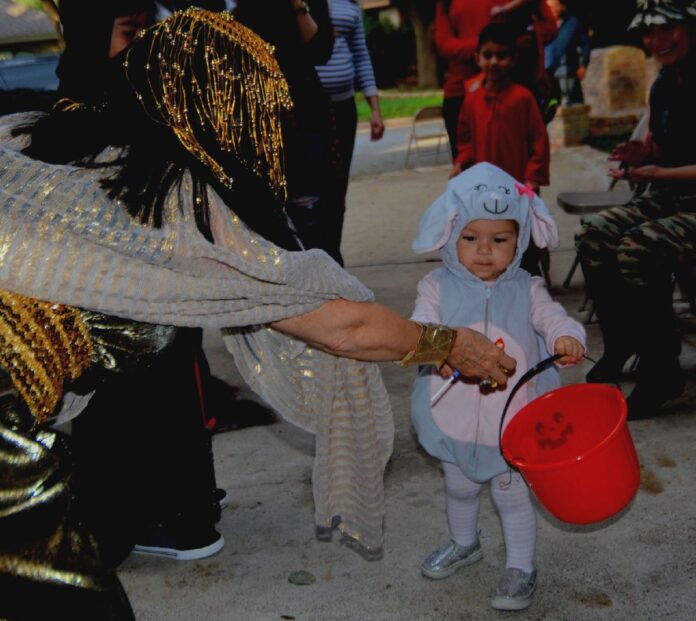BY PAUL SCHATTENBERG
COLLEGE STATION — While Halloween is a fun and exciting time for children, it can also be a dangerous one, especially if they are on the streets or in poorly lit or unfamiliar neighborhoods.
“There are many potential dangers for children out trick-or-treating,” said Bev Kellner, Texas A&M AgriLife Extension Service program manager in family and community health, College Station. “Having a safe Halloween requires that both parents and children are aware of these dangers and take the necessary steps to make Halloween as safe as possible.”
According to the Injury Facts 2016 report from the National Safety Council, in 2014 there were about 6,300 pedestrian deaths and 145,000 pedestrian injuries requiring medical consultation as a result of incidents with motor vehicles.
October ranks as the second-highest month in motor vehicle deaths in the U.S., and the Safe Kids organization notes children are more than twice as likely to be hit by a car and killed on Halloween than any other day of the year.
“Motorists need to be especially careful between 4 and 8 p.m., because that’s when most severe vehicle and young pedestrian collisions happen,” said Cindy Kovar, program coordinator with the Brazos Valley Injury Prevention Coalition. The coalition is a 10-county safe community initiative funded by the Texas Department of Transportation with the purpose of helping reduce traffic-related injuries and fatalities in the Brazos Valley.
“Motorists should drive slowly and not pass stopped vehicles, as the driver might be dropping off children,” Kovar said.
She said drivers should always yield to pedestrians and realize children may not notice their vehicle or wait to cross at an intersection.
“Slow down and expect that children may do something unpredictable,” she said. “And remember to ‘communicate’ with other drivers and pedestrians by using your turn signals. If you have to pull over to drop off or pick up your kids, use your hazard lights.”
Because nighttime driving is more dangerous, it requires extra attention from motorists as well as pedestrians and bicyclists, added Kellner, who oversees AgriLife passenger safety program.
“Motorists should not drink and drive on Halloween or any other time,” she added. “And parents or guardians should not allow children to go into poorly lit neighborhoods or areas without adequate sidewalks. A parent or responsible adult should always accompany younger children.”
She said motorists should watch carefully to see if there are any children on the streets, roadways, medians or curbs and should be especially careful when exiting driveways.
“Because many children dress in dark costumes, wear dark masks or darken their faces, you have to be especially careful after dark,” she added.
She said adults should instruct children to stop, look left, right and left again before crossing a street, as well as tell them to walk and not run from house to house or when crossing the street.
“Use a flashlight and wear retro-reflective strips or patches on clothing or costumes to be more visible to motorists,” she said. “Kids should cross the street only at intersections and crosswalks and walk on sidewalks whenever possible. If there are no sidewalks, they should walk on the left side of the street facing traffic.”
Michael Lopez, AgriLife Extension program specialist in family and community health, College Station, said there are also many “environmental” situations that can be dangerous to trick or treaters.
“In addition to only going into neighborhoods that have good infrastructure, such as good lighting, streets and sidewalks, it’s important that kids only go to homes with a porch light that’s on and never enter a home or car for a treat.”
He said both children and adults need to remain aware of their surroundings, so should put down any electronic devices and keep their heads up while walking on sidewalks or streets.
“Trick-or-treaters should stick together with a group and only trick or treat in a familiar area,” he said. “And they should never assume someone in a vehicle can see them, especially if the driver is turning or backing up.
“If they’re wearing a mask, they need to be sure the mask doesn’t obstruct vision or hearing and that their costume doesn’t impede their ability to walk or drive. They should wear comfortable clothing, including their costumes, and comfortable shoes to help them avoid falling or tripping.”
Lopez said parents should also discuss safety with their children before trick or treating.
“It’s a good idea to establish a place to meet and to discuss what to do in case they get lost or if there is an emergency,” he said. “Having children take a cellphone is a good idea, provided you encourage them to use it only if needed and pay attention to their surroundings while talking.”




